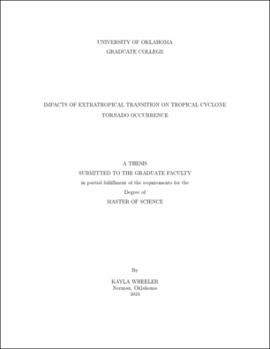| dc.description.abstract | Tornadoes that spawn from tropical cyclones (TCs) pose a threat to lives and property. Although nearly half of TCs in the Atlantic Ocean undergo extratropical transition, there has only been one study investigating how tornado occurrence changes during transition. The present study conducts a climatological analysis of the impact of extratropical transition on tornado occurrence in TCs from 1995--2020 by utilizing both observed TC and tornado data as well as radiosonde data. This study divided extratropical transition into three phases: tropical (i.e., pre-transition), transition, and extratropical (i.e., post-transition). The tropical and transition phases have the largest portion and the highest frequencies of tornadoes, whereas the extratropical phase has the fewest and least frequent tornadoes. Analysis of tornado location showed that tornadoes occur increasingly north and east as transition progresses, associated with the recurvature of TCs into the midlatitudes. Further analysis showed that as transition progresses, tornadoes tend to shift farther south within the TC, occur later in the day, and are associated with greater damage. These changes in tornado characteristics are associated with increases in synoptic-scale deep-tropospheric vertical wind shear while TC intensity weakens and the extent of the outer wind field expands. Evaluation of radiosondes showed that the downshear right quadrant of the TC is frequently the most favorable for tornado production, having the highest CAPE, lowest CIN, and highest storm-relative helicity (SRH) values. Throughout transition, CAPE in the downshear right quadrant decreases and CIN has no significant changes. SRH in this quadrant increases at the beginning of transition and decreases following transition. In all quadrants, CAPE tended to decrease as the lower troposphere became cooler and drier throughout transition, although those to the left-of-shear experienced this cooling sooner than right-of-shear. The strengthening of lower-tropospheric vertical wind shear at the beginning of transition results in increases in SRH followed by no significant changes into the extratropical phase. This work is the first comprehensive climatology of TC tornadoes in extratropically transitioning TCs and adds to the current understanding of environmental changes throughout extratropical transition. | en_US |
